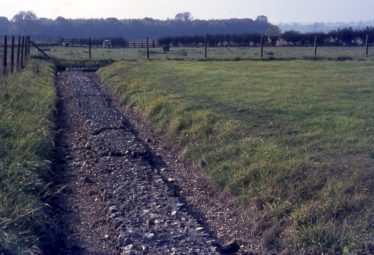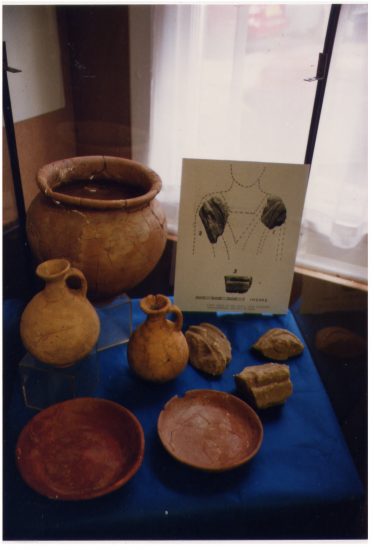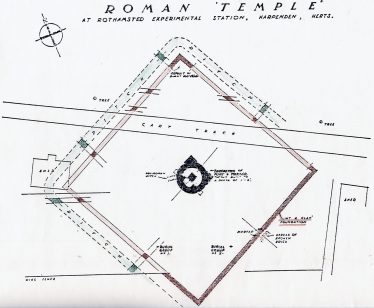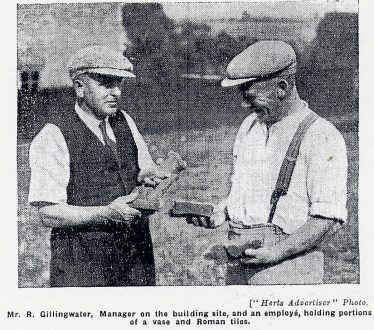Traces of Roman occupation
Fragments found by builders or in field surveys

Outer wall of Roman mausoleum, Rothamsted Farm (not accessible by public footpath)
Les Casey

Artefacts and fragments of sculpture found of the site of the Roman Mausoleum, Rothamsted,
LHS archives - LHS 5482 Les Casey. The objects are held by St Albans Museum Service

1937 Plan of the Mausoleum - at first thought to be a temple.
St Albans & Hertfordshire Architectural and Archaeological Society, reproduced in WEA Vol 1, The Settlement of Wheathampstead & Harpenden

Workmen holding fragments of pottery & tiles found on a building site in Crabtree Lane
Herts Advertiser, 26 Aug 1938, in LHS archives

Excavations at Turner' Hall by St Albans Museum service, August 2003
Peter Boden
In addition to a network of pre-Roman and Roman trackways and roads passing through Harpenden, evidence of Roman occupation has been found at various sites throughout the area, in the form of tesserae, pot sherds, tiles and other artefacts. These include:
- a villa on the banks of the Ver, near Harpendenbury
- indications of habitation on Black Croft Field, Great Knott Field and Hoos field, on the Rothamsted estate
- the footings of a mausoleum or shrine at Collye Grove on the Rothamsted estate, which was excavated in the early 1930s – see illustrations and the Comment below.
- fragments of a ‘mortarium’ in Moreton End Lane
- Roman pottery on the site of Roundwood Park school
- Romano-British burial mound alongside Coldharbour Lane (see our page on Burial Mound in Lea Valley)
- A Roman oil lamp in the embankment of the former railway line near Coldharbour
- Carved fragments and half columns incorporated in The Granary, (former Top Street farm, Crabtree Lane) – which had been rebuilt in 1650 (demolished in the 1950s). Further details in our page on Burial Mound in Lea Valley.
- pieces of Roman pottery and roof tiles unearthed by work on a housing development off Crabtree Lane (Holly Walk, Weybourne Drive, Glemsford Drive), from what was thought to be a Roman villa overlooking the Lea Valley, as reported in the Herts Advertiser of 26 August 1938 – see illustration
- shrines at Friars Wash – excavated by Time Team
- burial and villa at Turner’s Hall Farm, Marshalls Heath, Wheathampstead (see illustration)
There are likely to be more traces of the past under our feet, or our gardens - but modern building methods, with heavy plant, are likely to destroy evidence.

Comments about this page
The gentleman who discovered the mausoleum up by Rothamsted farm (who used to live in what is now the Rectory in Rothamsted Avenue – he left his house to the church) deduced that something was there because previously there was an Australian tank on the site. He wondered why someone would put such a structure there, in particular, and assumed that is must have benefited from some form of support…one thing lead to another, he investigated and discovered the remains. We have some Roman artefacts from the site that he gave to my father, who lived in Ave St Nicholas at the time of the original excavation.
Add a comment about this page